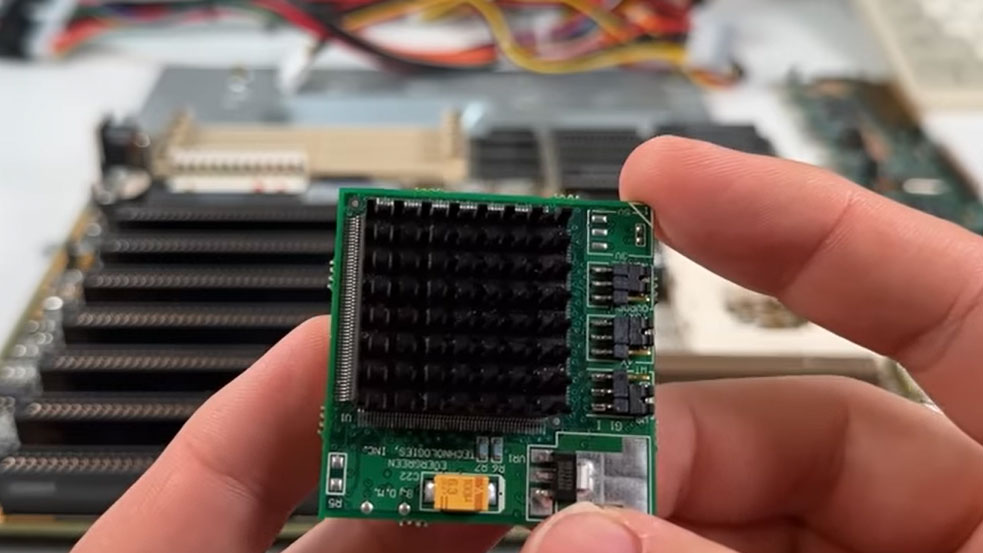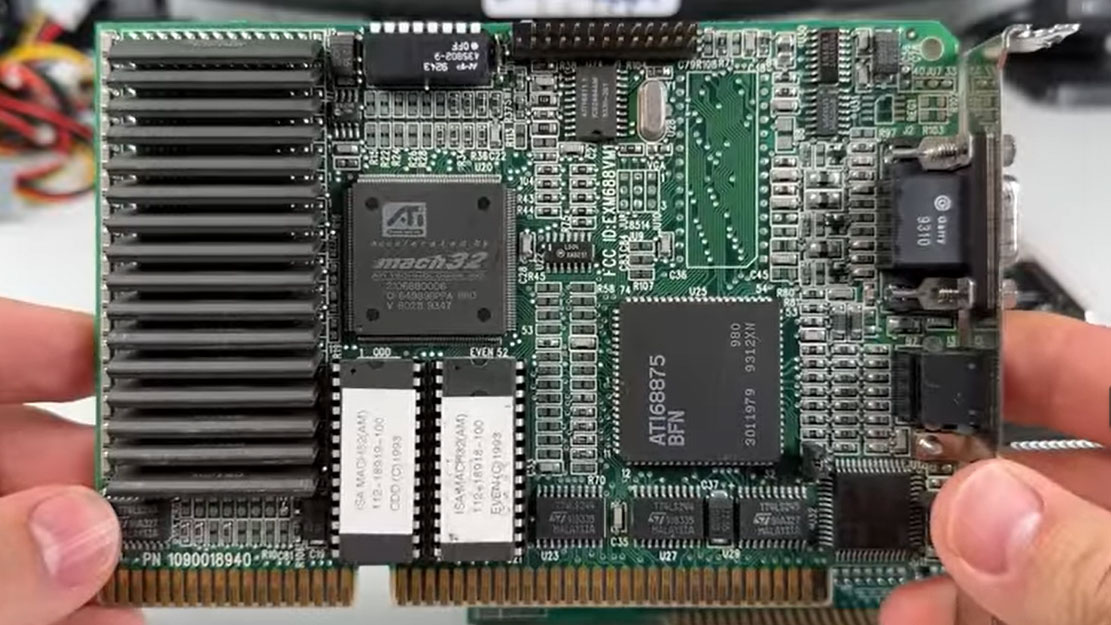Frustrated Retro Gamer Overclocks ISA Bus Over 200%
Doom felt slow on an ISA graphics card system, until the bus got overclocked 212%

YouTuber VswitchZero was a little disappointed after getting his hands on a servicable old 486 DX66 and firing up Doom. Wearing the rose-tinted spectacles of PC gaming nostalgia, one might expect one of the fastest pre-Pentium systems to offer quick and slick Doom thrills, but VswitchZero lamented that Doom ran “very choppy, and [it was] not a lot of fun to play.” The issues were largely caused by the PC’s ISA bus graphics, so the YouTuber decided to work on a project to overclock the ISA bus to the max... resulting in a successful overclock of 212% recorded.

VswitchZero’s ISA hijinks were partly inspired by the acquisition of a 1992 vintage DEC Digital system with ISA slots only, as mentioned above. Further inspiration came from a YouTube channel called CPU Galaxy, which ran an ISA Doom 25 FPS challenge for subscribers. The name of the challenge provides a hint at the low frame rates pioneering PC 3D gamers had to suffer.
For some background to ISA bus overclocking, the bus speed of this old 16-bit interface was usually ~8 MHz. The ISA clock was typically derived from a divider of the front side bus speed. For example, with a CPU running at 33 MHz, a divider of a quarter was used, so the ISA bus would run at 8.25 MHz. However, some motherboards had an independent clock generator crystal. Whichever way your motherboard was configured, adjusting the divider could provide some interesting ISA overclocking opportunities. For contemporaneous graphics cards, which would potentially saturate the 16-bit 8 MHz ISA bus, some decent gains could be attained using this overclocking method.

VswitchZero’s video shows us the old ISA system he put together for his overclocking feat. The YouTuber talks us through the ‘rules’ of the ISA Doom 25 FPS challenge and his choices for motherboard, CPU, RAM, storage, and video card. These choices are important, as some parts are more flexible or malleable to the overclocker’s will, while others will quickly become unhappy with any ISA overclocking — impacting performance and stability.
The system motherboard chosen was an Asus model with SIS chipset, which offers some decent tweakability. Interestingly, the CPU used was an Evergreen upgrade socket AMD 5x86 chip which was praised for its performance, multiplier, and bus frequency flexibility. The ISA graphics card selected was the ATI Mach 32, which apparently was a sweet spot choice for ISA systems and overclocking.
Initial overclock testing with the ISA bus pushed to 11 MHz fell flat, as a BIOS bug meant the divider setting change didn’t result in a faster bus speed. A BIOS update (which was rather laborious and required specialized hardware) did the job. Most importantly, the Doom benchmark showed that an average 21.9 fps was achieved with the 11 MHz ISA bus. VswitchZero was relaxed about still being some distance from beating 25 fps, as there remained optimizations for front side bus (FSB overclocking), CPU overclocking, and other ISA dividers to test.
Configuring a 50 MHz FSB, and 3x multiplier, resulting in a 150 MHz CPU clock had a larger impact. Memory timings and wait states could stay at the lowest values possible, with only the cache read state needing some reduction. With these settings and a 12.5 ISA bus speed, Doom ran stably at 25.1 fps. The YouTuber had cracked the 25 fps milestone.
Get Tom's Hardware's best news and in-depth reviews, straight to your inbox.
Next, applying a divider to run the ISA bus at 16.67 MHz worked out without any glitches or other side-effects. Doom could run at 30.4 fps given these settings.


Moving up to an amazing ISA bus speed of 25 MHz, the system remained stable, and VswitchZero says the system could rival VESA Local Bus systems in benchmarks. As for Doom, it managed a flawless run at 35.7 fps. This was quite a feat, considering it started at less than 20 fps.
At the end of the main testing spree, VswitchZero decided to assess some different components, including other ISA graphics cards. You can see the further testing and follow the discussion of the different parts in the video embedded above.

Mark Tyson is a news editor at Tom's Hardware. He enjoys covering the full breadth of PC tech; from business and semiconductor design to products approaching the edge of reason.
-
ex_bubblehead Kids today, always thinking they've discovered something no one else has ever thought of. This was quite regularly done back in the day. Not news at all.Reply -
bit_user Cool to do this "for science" but...Reply
Moving up to an amazing ISA bus speed of 25 MHz, the system remained stable, and VswitchZero says the system could rival VESA Local Bus systems in benchmarks.
I didn't think there even were any 486DX2-66 that didn't have a VLB slot.
In between, another option was EISA. I had a friend with a 486DX-50 (at least I think it was DX, not DX2) and it had an EISA graphics card but not VLB. EISA was 2x the bandwidth of ISA, I think for being 32-bit instead of 16-bit. -
bit_user Reply
I had never heard of overclocking, back in the day, but someone later told me that you could overclock a 386 by similar (~2x) amounts! I wish I'd have known back then, but actually no way my dad would've let me risk frying his CPU.ex_bubblehead said:This was quite regularly done back in the day. Not news at all. -
OriginFree Replybit_user said:I had never heard of overclocking, back in the day, but someone later told me that you could overclock a 386 by similar (~2x) amounts! I wish I'd have known back then, but actually no way my dad would've let me risk frying his CPU.
Yes this was definitely a thing all the way back to the 8086 / 8088 (not sure about earlier). We routinely overclocked our 286 / 386SX / DX to get that extra boost. Going from 12 MHz to 16 was a huge jump (33%+) and was routine in our circles. Especially once the hardware was "outdated" and they were given to us to scrap once the new hardware came in. It's much more fun to play with a machine that you don't have to pay to replace if things go sideways.
Then we got drop in replacements (which I know date back to at least the 8088/8086 days), clock "doubled" chips and eventually chips that overclocked themselves.
I have to admit I do miss spending the week tweaking a system & the boot files just to be able to get the newest software to run on the weekend. Then again I may have blocked out all the bad parts 30+ years on. -
vern72 Reply
When I got my first PC (a 486DX/20), I insisted that it have PCI slots. I never had VL-Bus in any of my systems.bit_user said:I didn't think there even were any 486DX2-66 that didn't have a VLB slot.
-
bit_user Reply
That's interesting. I never heard of a 486DX/20. 486SX/20, sure.vern72 said:When I got my first PC (a 486DX/20), I insisted that it have PCI slots. I never had VL-Bus in any of my systems.
PCI didn't come along until the Pentium, which means older, lower-speed 486's were all ISA, EISA, or VLB. I never heard anything bad about VLB. Given the choice, I'd definitely go with PCI, though.
I had an AMD 486DX3-120, IIRC. And it had PCI slots. Weirdly, it ran PCI at 40 MHz, which was out-of-spec. -
Amdlova I have a little time with a 486 dx... I don't remember if I make some oc via jumper... jumped after for a pentium and make some overclock... man the math with the jumpers good times. Today you enter in bios do some increments and it's done.Reply -
Stesmi Reply
I don't recall a 486DX-20, either. Doesn't mean one didn't exist, DX-25, yes.bit_user said:That's interesting. I never heard of a 486DX/20. 486SX/20, sure.
PCI didn't come along until the Pentium, which means older, lower-speed 486's were all ISA, EISA, or VLB. I never heard anything bad about VLB. Given the choice, I'd definitely go with PCI, though.
I had an AMD 486DX3-120, IIRC. And it had PCI slots. Weirdly, it ran PCI at 40 MHz, which was out-of-spec.
Remember that early in the Pentium era, when they were hard to get hold of and got recalled, etc, there were some 486 PCI motherboards out there to cate for the Ooh Ahh new bus (PCI), but affordable/can get hold of. I know I saw one. Wasn't there a MicroStar motherboard with PCI back in like 1995, and something like a Pine Technology or something?
Found one, but I don't know when it's from.
https://theretroweb.com/motherboard/manual/pt-431a-man-60673d25230cd160845313.pdf -
Stesmi Reply
Very many ISA cards that had trouble going up in bus speed. Personally I never heard of anyone going as high as 25MHz. What cards did you regularly run at 25MHz or above?ex_bubblehead said:Kids today, always thinking they've discovered something no one else has ever thought of. This was quite regularly done back in the day. Not news at all. -
jonfitch 486s really were pushed to the limit to try to run the original Doom engine. You really needed a Pentium 75 at the minimum, if not a Pentium 100 MHz to run without any hitches.Reply
